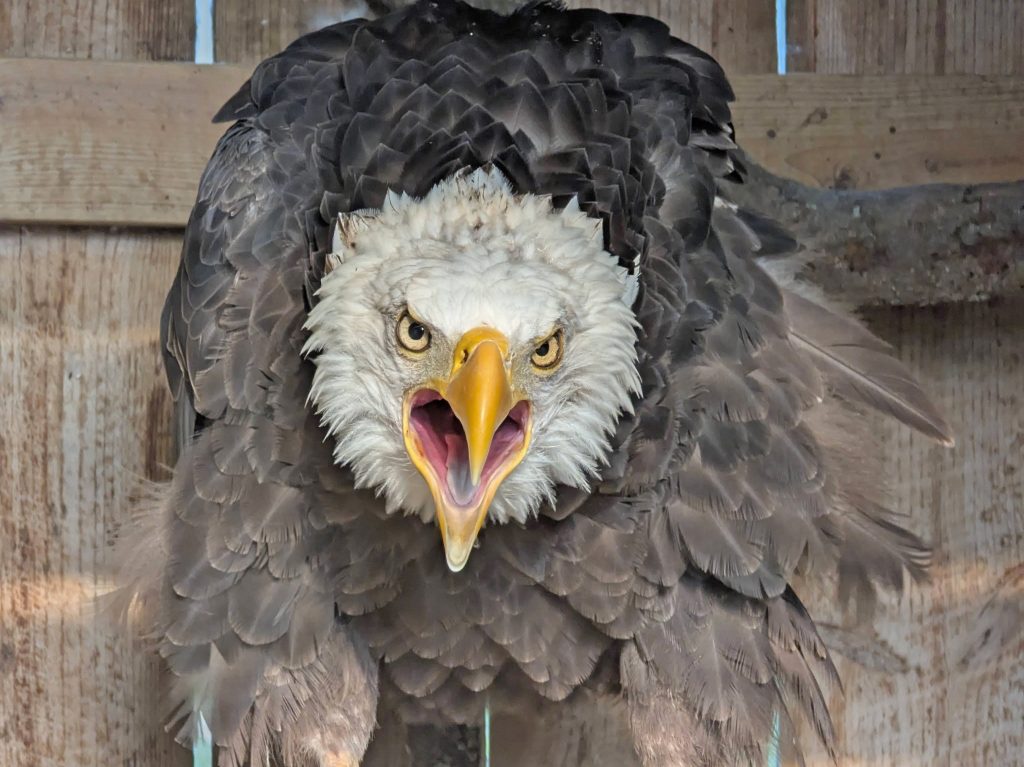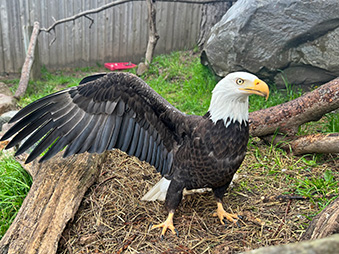Haliaeetus leucocephalus | Bald Eagle
Name: Aerie (male)



Meet Aerie: A Star of the Sky
With a wingspan as wide as a couch and eyesight that rivals binoculars, Aerie is a true symbol of power and grace. This Bald Eagle, North America’s national bird, live here in the Forgotten Forest and is an ambassadors for his counterparts in the wild. Though he can no longer survive in the wild due to past injuries, he now serves an even more important role—educating visitors and inspiring conservation action.
You can find Aerie by heading right after admissions, walking through the Forgotten Forest, and following the ramp up to his habitat—just kitty-corner from Dean the Raven.
Big Birds with a Bigger Presence
Adult Bald Eagles are hard to miss—with striking white heads, bright yellow beaks, and wingspans that stretch up to 8 feet! But they don’t start out that way. Bald Eagles go through 5 years of color changes before reaching their iconic adult plumage. Juveniles are mostly brown and often confused with Golden Eagles and other large birds of prey.
Bald eagles are also expert co-parents. Both male and female Bald Eagles help build massive nests—often 5 feet wide and 2–4 feet tall—and both take part in raising their young. The largest eagle nest on record measured 10 feet wide and 20 feet tall and weighed over 2 tons after 30 years of use!
Sharp Eyes, Strong Talons
- Favorite food? Fish! Bald Eagles are carnivorous opportunistic foragers, meaning they’ll eat whatever meat they can get, from waterfowl and small mammals to carrion (animals that have passed away) left behind by other predators.
- They can see prey from 4 miles away, earning the nickname “eagle eyes."
- Their talons have 10x the grip strength of a human hand—strong enough to snatch fish out of water mid-flight!
During winter months, especially in northern areas like Michigan, eagles rely more heavily on scavenging, often gathering near open water or roadkill for easy meals.
Why Isn't He Flying Away?
Guests often ask why Aerie doesn't leave his open-top habitat. He sustained injuries in the wild, most likely due to vehicle collisions, that have permanently affected his ability to fly.
And he's not alone. According to the U.S. Fish & Wildlife Service, 89 to 340 million birds are killed in vehicle collisions every year in the U.S.—and Bald Eagles are among them. These birds are often seen near roadsides feeding on roadkill, which puts them in danger of being struck by passing cars. If you are driving along our highways and see that there is a deceased animal in a dangerous position, be mindful of scavengers and reach out to your local city hall or county road commission to dispose of the remains.
Fact Sheet
Taxonomy
Genus: Haliaeetus | Species: leucocephalus
Kingdom: Animalia | Phylum: Chordata | Class: Aves | Order: Accipitriformes | Family: Accipitridae |
Favorite Enrichment Type
Large tubs to bathe in!
Life Span
- In the Wild: 15 to 25 years
- In Human Care: Up to 50 years
Diet
- In the Wild: Fish, birds, lizards, small mammals, and scavenged carrion.
- At the Zoo: Fish and frozen thawed rats.
Geographic Range
primarily in North America, including Alaska, Canada, the United States, and northern Mexico.
Habitat
Coastal forests, marshes, lakes, and mountains.
Eagle Fast Facts:
- Range: Alaska, Canada, the U.S., and northern Mexico.
- Wingspan: Up to 8 feet.
- Lifespan: 15–25 years in the wild; up to 50 in human care.
- Nests can weigh 2 tons and stand 20 feet tall.
- Vision: Can spot a rabbit from 4 miles away.
- Talon grip: 400+ psi, that is 10x stronger than a human hand!
- Excellent parents: both raise the chicks.
- Scavengers: often feed on roadkill—putting them at risk near roads.
Status: Least Concern
Conservation: A Soaring Success
The story of the Bald Eagle is one of the greatest conservation success stories in U.S. history.
By the 1960s, Bald Eagle populations were plummeting due to habitat loss, illegal hunting, and the widespread use of DDT. DDT (dichloro-diphenyl-trichloroethane) is a pesticide that causes their eggshells to become dangerously thin, making it difficult to impossible for their chicks to hatch appropriately.
- In 1967, Bald Eagles were listed under the Endangered Species Preservation Act.
- By 1972, DDT was banned in the U.S., and strict protections were put in place.
- Thanks to decades of recovery work, they were delisted in 2007 and are now classified as Least Concern—but the work to protect them continues!
How You Can Help
You don’t need wings to make a difference. Here’s how you can protect Bald Eagles and other birds of prey:
- Reduce single-use plastics – Keep waterways clean
- Use natural lawn care – Avoid pesticides and harmful chemicals
- Clean up fishing lines – Discard lines and hooks properly
- Avoid lead ammunition and tackle – Lead poisoning is a serious threat to birds that scavenge, like eagles. Switch to non-lead alternatives!
Aerie may no longer soar through the skies, but he continues to inspire awe and action from right here in the Forgotten Forest. Come meet him, learn his story, and discover how you can help protect birds of prey for generations to come.
How to Find Us
After entering the zoo through the admissions booth, head to the right to enter the Forgotten Forest! Once in the Forgotten Forest, our eagle is located up the left ramp and kitty-corner to Dean the Raven.
